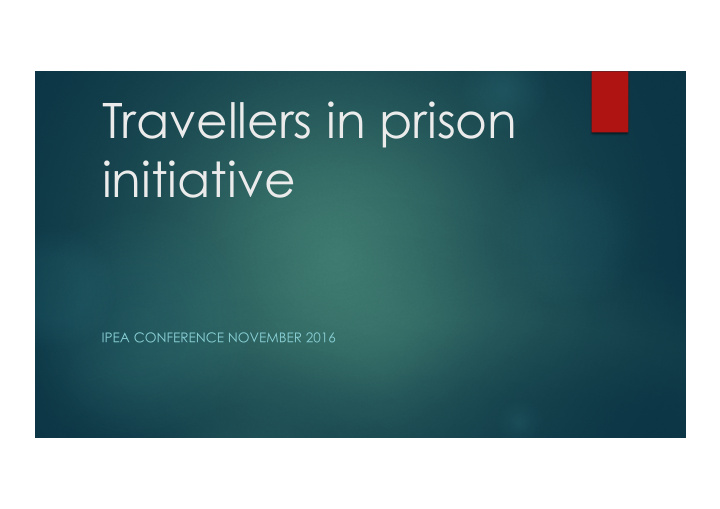



Travellers in prison initiative IPEA CONFERENCE NOVEMBER 2016
Irish Penal Reform Trust ‘Irish Penal Reform Trust’ (2014) Travellers in the Irish Prison System – A Qualitative Study http://www.iprt.ie/files/ IPRT_Travellers_Report_web.pdf
Travellers in the Irish prison system – findings from previous research � Travellers over-represented in prison – (all ireland Travellers health study) � Travellers make up less than 1% of population but according to IPS estimates � Traveller women make up over 20 % of the prison population � and Traveller men up to 15%
Travellers as a % of the population
Traveller women as a % of women in prison
Main findings from IPRT report
Why might Travellers be over- represented in prison system?? � Socio-economic factors – difficulty in making a living legitimately – (theft), low levels of education, poor living conditions, chaos/ violence � Increasing dependency on drugs and alcohol � Mental health problems � Discrimination in society and in the criminal justice system (internalised oppression, over policed, more likely to be detained, harsher sentences??) � Without ethnic identifier we cant really know why!
Key issues for Travellers in prison? � Discrimination � Not accessing services/supports in prison –(literacy – difficulties accessing information, negative associations with accessing services especially a school environment � Contact with family – impact of being separated from family, and missing important family occasions � Internal conflict in prison – protection wing � Depression and other mental health problems
Particular issues for Traveller women � Stigma � Traveller women are more likely than other women in prison to be mothers, to have a greater number of children, and to have children at a younger age and more likely that their children are in care � Mental health issues (even more common than among Traveller men) � Possibly leaving and returning to a violent/abusive situation � Problem of finding somewhere to live post-release
Aims and objectives of Travellers in prison initiative � Improve outcomes for Travellers in prison and their families and to reduce re- offending
Summary of Activities Actions TPI Programmes Ethnic Data Collection and Monitoring Traveller Women in Prison Research 1 Building a knowledge base about Travellers in prison Learning from other Places
Summary of Activities Actions TPI Programmes Understanding more about Access – (interviews with service providers) 2. Increasing and improving access to prison-based Encouraging and Promoting services for Travellers Access -ETB Counselling Services Continuum
Summary of Activities Actions TPI Programmes Piloting Family Support Model 3. Strengthening supports for families of Travellers in prison, and after prison, using a multi-agency approach3 Developing Family Support Resources
Summary of Activities Actions TPI Programmes Prison-based Peer Support Groups Prison-based Peer Mediation 4 Strengthening Self-identity and Self-advocacy for Travellers in prison by mainstreaming a peer-support model TPI Newsletter TPI Network
Increasing Traveller participation in prison-based services has three primary strands: � 1) Encouraging Travellers to want to participate � 2) Creating an atmosphere in prison in which participation is both normal and positive � 3) Providing suitable services in prison
Public Sector Duty � The public sector equality and human rights duty, which was introduced with the enactment of the Irish Human Rights and Equality Commission Act 2014 requires all public bodies to take proactive steps to: � (a) eliminate discrimination, � (b) promote equality of opportunity and treatment of its staff and the persons to whom it provides services, and � (c) protect the human rights of its members, staff and the persons to whom it provides services.
Public sector bodies are required: � To develop a plan and actions to be put in place to address those issues in the organisations strategic plan � And report in a manner that is accessible to the public on developments and achievements in that regard in an annual report
� The introduction of the Public Sector Duty and the support and guidance of the Irish Human Rights and Equality Commission, should lead to the further development of a systematic integration of an equality and human rights perspective into the ongoing work of the prison service in Ireland.
ANY QUESTIONS??? � THANK YOU……
Recommend
More recommend